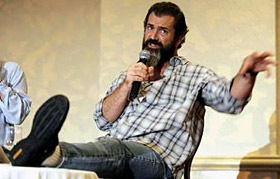 |
 |
 |
 Entertainment | October 2005 Entertainment | October 2005  
Mayan Culture Mel Gibson’s New Passion
 Reed Johnson - LATimes Reed Johnson - LATimes


| | Actor-director Mel Gibson gestures during a news conference at Veracruz port in Mexico October 28, 2005. Gibson is currently scouting Mexican locations for his new film 'Apocalypto,' a violent action movie set in an ancient civilisation around 3,000 years ago. (Reuters/Felipe Courzo) |
Veracruz, Mexico - At first, his responses were cautious, even cryptic. The plot of his new movie, “Apocalypto”? “It doesn’t bode well to say too much about what you’re doing,” Mel Gibson replied.

But as he relaxed - and the mob of assembled reporters and photographers got their high spirits under control - Gibson slowly began to fill in the blanks on his new movie, which so far has been almost as obscure as its historic backdrop: the ancient Mayan Indian empire that rose, thrived and mysteriously collapsed centuries before the Spanish conquistadors planted their boots in the New World.

Gibson might have reasons for keeping a relatively low profile with “Apocalypto.” The last time most of the world caught sight of him, roughly two years ago, he was smack in the middle of a hurricane’s eye surrounding his film “The Passion of the Christ.” In the end, Gibson rode out the waves of protest and “The Passion” went on to become a monster worldwide hit.

By comparison, “Apocalypto” had been shrouded in secrecy until a Friday news conference at this ancient port city which, fittingly, is where the conqueror Hernan Cortes landed in the early 1500s en route to demolishing the Aztec empire.

Civilizations rise and fall, often for similar reasons, Gibson observed during the course of his roughly one-hour encounter with the mostly Mexican journalists. “I’m hoping that by focusing on this civilization we’re able to be introspective about ourselves,” said Gibson, who co-wrote the movie and is directing, producing and thus far financing it by himself. He is not acting in the movie.

Gibson said that the plot of “Apocalypto” - a Greek word that translates as “new beginning” - concerns an Indian family man who “has to overcome tremendous odds to preserve what he values the most.” The movie will employ relatively unknown actors along with hundreds of extras and will employ Mayan dialect.

Gibson hopes that one effect of the film is to bolster a threatened idiom that frequently is treated with disrespect, as an inferior language, in Latin American societies. “My hope is that it (the movie) makes this language cool again and that they (indigenous people) speak it with pride,” he said.

The director has endeared himself to his hosts by offering $1 million to reconstruction efforts following Hurricane Stan, which devastated Mexico and Central America earlier this month. The Mexican media gave good play to images of Gibson meeting with President Vicente Fox at the presidential palace recently. Tourism officials are hoping that production of “Apocalypto,” due to begin shooting in mid-November, will pump $20 million into the economy.

Gibson said he and his co-writer, Farhad Safinia, began sketching out the storyline for “Apocalypto” first, then later came up with the movie’s historical setting and context. “A lot of it, story-wise, I just made up,” he said, “and then, oddly, when I checked it out with historians and archaeologists and so forth, it’s not that far (off).”

He apparently has been doing a lot of homework. He scouted movie sites in Costa Rica, Guatemala and the Yucatan peninsula, as well as the Veracruz region, and investigated a number of ancient ruins.

For background on the Mayan civilization, he drew on a wide variety of sources, including accounts by the Spanish missionaries and the ancient Mayan spiritual treatise, the Popol Vuh. He also said he was reading or planning to read several books about the Mayans and the rise and fall of other civilizations, including Charles C. Mann’s recently published “1491.”

In explaining his film’s title, Gibson emphasized that “apocalypto” implies the arrival of a new order to replace an existing one, a theme he has touched on in other movies. In “Gallipoli” he played an Australian soldier trapped in the bloody carnage of Europe’s World War I auto-annihilation. Several other films he has been involved with, including “The Year of Living Dangerously,” “Braveheart,” “The Patriot,” “We Were Soldiers” “The Passion” and the “Mad Max” trilogy, deal with societies in times of grave stress or empires on the verge of upheaval.

Gibson suggested that certain viewers of the Disney-distributed “Apocalypto” might need sturdy constitutions. Asked whether he had any plans to make children’s movies, the filmmaker known for such blood-drenched epics as “Braveheart” replied, “Hey, this is for kids with strong stomachs.”

But while violence might be an unavoidable ingredient in a story about a civilization in conflict, so too is a quest for understanding, Gibson indicated. Immersing himself in the ancient Mayan worldview, following the Judeo-Christian worldview of “The Passion,” has been “kind of this anthropological journey,” Gibson said. “It’s amazing, it’s fascinating, and it makes your brain work overtime. In fact, you meet yourself coming and going. I mean, there are some questions that you simply can’t answer. But that doesn’t stop the search.” | 
 | |
 |



